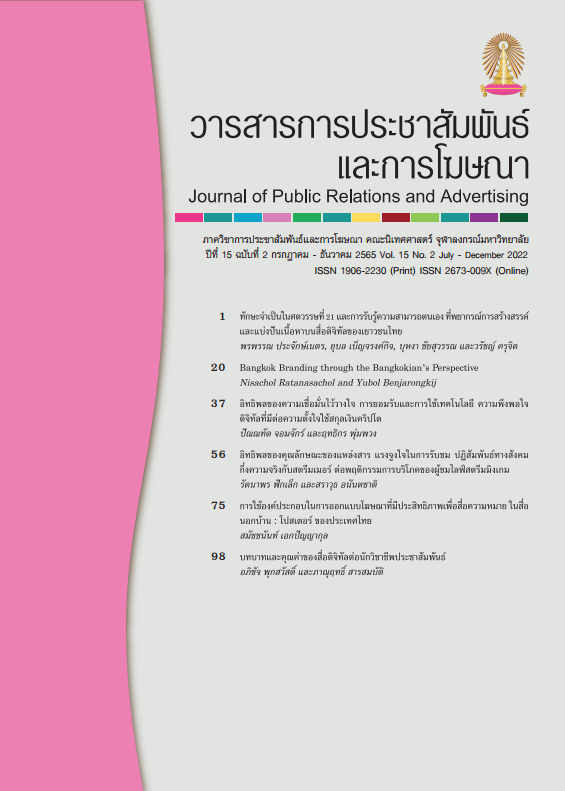The Use of Effective Verbal and Visual Components in Thai Out of Home Advertising Design: Poster
Main Article Content
Abstract
The objectives of this research were 1) to study and analyze the use of effective copy / verbal and visual components in Thai out of home advertising design: posters and 2) To study the trend of advertising design in out of home media: current posters in Thailand. This research is content analysis research, which is based on reliable information from books and textbooks on verbal components, the commonly used presentation techniques and the type of poster. These will be the criteria for analyzing out of home advertising examples from finalists and winners of the advertising and marketing communications contest, namely “Adman Awards” in Thailand during 2015 – 2019, totally of 83 pieces. The results of the research revealed that the poster design consisted of five elements of verbal components as follows: 1) Headline 2) Baseline 3) Sub Headline 4) Caption 5) Body Copy. The most commonly used for poster designing is headline. The headline as a picture caption is the most used to convey a message that uses headline together with the visual in which the receiver has to see the headline text together with the visual to understand clearly the ideas that creators want to communicate. For visual, the results of the research revealed that there are 11 presentation techniques for the poster design as follows: 1) Slice of Life 2) Problem 3) Analogy 4) Off beat or Surrealistic 5) Before & After 6) Dramatization 7) Demonstration 8) Presenter 9) Documentary 10) Symbolic 11) Production Number. The slice of life advertising tactic is the most used to convey a message. The story (Execution) mainly presents scenarios that may occur in the daily life of the target audience. The audience may have been in such situations before or may occur in their lives in which the products and services may be able to solve those problems or be able to avoid such situations or improve their quality of life. Besides,the photograph is commonly used in poster designing to convey abstract meaning. The trends of advertising design in out of home media: current posters in Thailand provide a guideline according to the key components that appear on the poster. The results of the research revealed that there are two types of the poster as follows: 1) Poster with Copy/text and visual 2) Visual poster. Poster with copy/text and visual is the most used to convey a message. The audience and receiver have to see both visual and copy to understand the advertising concept that the creator wants to communicate. It is found that the Headline as a picture caption is commonly used in poster design.
Article Details
References
กรุ๊ปเอ็ม(ประเทศไทย). (2563). สื่อโฆษณานอกบ้าน. วันที่เข้าถึงข้อมูล 24 พฤษภาคม 2563, แหล่งที่มา http://www. http://www.groupmthailand.com
กัลยกร วรกุลลัฏฐานีย์ และ พรทิพย์ สัมปัตตะวนิช. (2553). การโฆษณาเบื้องต้น. กรุงเทพฯ: สำนักพิมพ์มหาวิทยาลัยธรรมศาสตร์.
จริยา ปันทวังกูร. (2551). การเขียนบทโฆษณา. กรุงเทพฯ : สำนักพิมพ์แห่งจุฬาลงกรณ์มหาวิทยาลัย.
บริษัท มาสเตอร์ แอด จำกัด (มหาชน). (2563). นิยามสื่อโฆษณานอกบ้าน ปี 2020. วันที่เข้าถึงข้อมูล 23 พฤษภาคม 2563, แหล่งที่มา http://www.masterad.com
วรรณธนา จิรมหาศาล. (ม.ป.ป.). ประเภทของโปสเตอร์ 3 รูปแบบ. วันที่เข้าถึงข้อมูล 1 สิงหาคม 2563, แหล่งที่มา http://www.thaischool.in.th/_files_school/10106250/data/10106250_1_20170127-133346.pdf
สกนธ์ ภู่งามดี. (2546). การออกแบบและผลิตงานโฆษณา. กรุงเทพฯ: แซท โฟร์ พริ้นติ้ง จำกัด.
สมัชชนันท์ เอกปัญญากุล. (2558). การเขียนข้อความโฆษณา. กรุงเทพฯ: สำนักพิมพ์มหาวิทยาลัยธรรมศาสตร์.
เสรี วงษ์มณฑา. (2547). ครบเครื่องเรื่องการสื่อสารการตลาด. กรุงเทพฯ: บริษัทธรรมสาร จำกัด.
อารยะ ศรีกัลยาณบุตร. (2550). การออกแบบสิ่งพิมพ์. กรุงเทพฯ: บริษัทวิสคอมเซ็นเตอร์.
แอดแมน อวอร์ส. (2563). Adman History. วันที่เข้าถึงข้อมูล 20 พฤษภาคม 2563, แหล่งที่มา http://www.admanawards.com
Cao, X. (2020). Research on the Visual Composition of Public Service Advertising Poster Design, In Proceedings of Advances in Social Science, Education and Humanities Research: Vol.515 (pp.477-479). Moscow: Atlantis Press.


